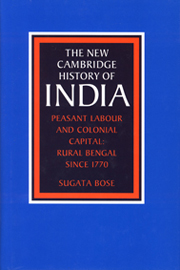Crossref Citations
This Book has been
cited by the following publications. This list is generated based on data provided by Crossref.
de Haan, Arjan
and
Rogaly, Ben
1994.
Eastward Ho! Leapfrogging and Seasonal Migration in Eastern India.
South Asia Research,
Vol. 14,
Issue. 1,
p.
36.
Noiret, Serge
1995.
Publications on financial history 1993.
Financial History Review,
Vol. 2,
Issue. 2,
p.
163.
Urban, Hugh B.
1996.
The poor company: Economics and ecstasy in the Kartabhaja sect of colonial Bengal∗.
South Asia: Journal of South Asian Studies,
Vol. 19,
Issue. 2,
p.
1.
Drèze, Jean
and
Gazdar, Haris
1997.
Indian Development.
p.
33.
Sengupta, Sunil
and
Gazdar, Haris
1997.
Indian Development.
p.
129.
Williams, Glyn
1999.
Assessing Poverty and Poverty Alleviation: Evidence from West Bengal.
Transactions of the Institute of British Geographers,
Vol. 24,
Issue. 2,
p.
193.
Tagliacozzo, Eric
2002.
Trade, Production, and Incorporation. The Indian Ocean in Flux, 1600–1900.
Itinerario,
Vol. 26,
Issue. 1,
p.
75.
Rogaly, Ben
Coppard, Daniel
Rana, Kumar
Rafique, Abdur
Sengupta, Amrita
and
Biswas, Jhuma
2003.
Seasonal migration, employer-worker interactions, and shifting ethnic identities in contemporary West Bengal.
Contributions to Indian Sociology,
Vol. 37,
Issue. 1-2,
p.
281.
Rogaly, Ben
and
Rafique, Abdur
2003.
Struggling to Save Cash: Seasonal Migration and Vulnerability in West Bengal, India.
Development and Change,
Vol. 34,
Issue. 4,
p.
659.
Munshi, Debashish
and
Kurian, Priya
2005.
Imperializing spin cycles: A postcolonial look at public relations, greenwashing, and the separation of publics.
Public Relations Review,
Vol. 31,
Issue. 4,
p.
513.
Bhargava, Meena
2006.
Changing River Courses in North India: Calamities, Bounties, Strategies—Sixteenth to Early Nineteenth Centuries.
The Medieval History Journal,
Vol. 10,
Issue. 1-2,
p.
183.
McCreery, David
2006.
From Silver to Cocaine.
p.
53.
Saikia, Arupjyoti
2008.
State, peasants and land reclamation.
The Indian Economic & Social History Review,
Vol. 45,
Issue. 1,
p.
77.
Wilson, Jon E.
2008.
The Domination of Strangers.
p.
104.
Ó GRÁDA, CORMAC
2008.
The ripple that drowns? Twentieth‐century famines in China and India as economic history1.
The Economic History Review,
Vol. 61,
Issue. s1,
p.
5.
2009.
Stages of Capital.
p.
143.
2009.
Stages of Capital.
p.
199.
2009.
Stages of Capital.
p.
232.
ROY, HAIMANTI
2009.
A Partition of Contingency? Public Discourse in Bengal, 1946–1947.
Modern Asian Studies,
Vol. 43,
Issue. 6,
p.
1355.
2009.
Stages of Capital.
p.
103.





